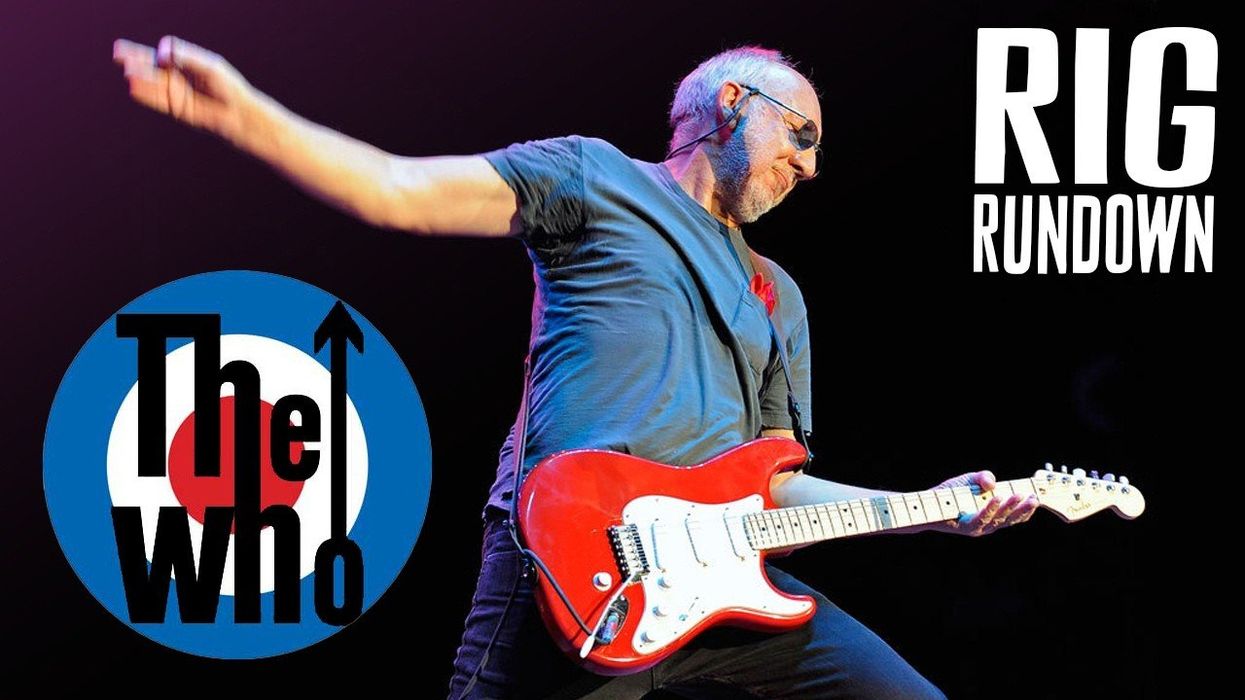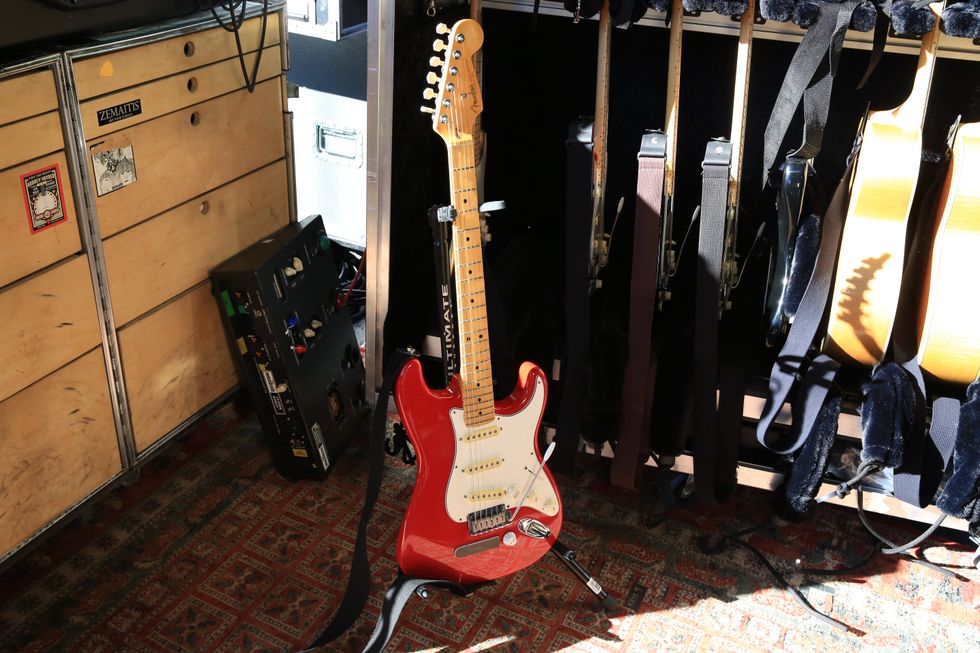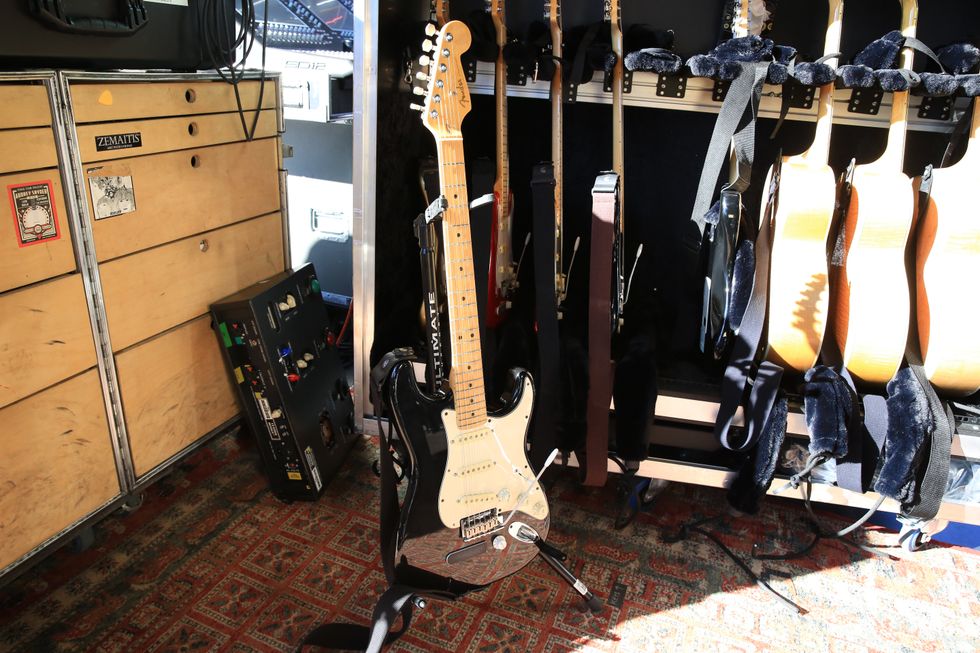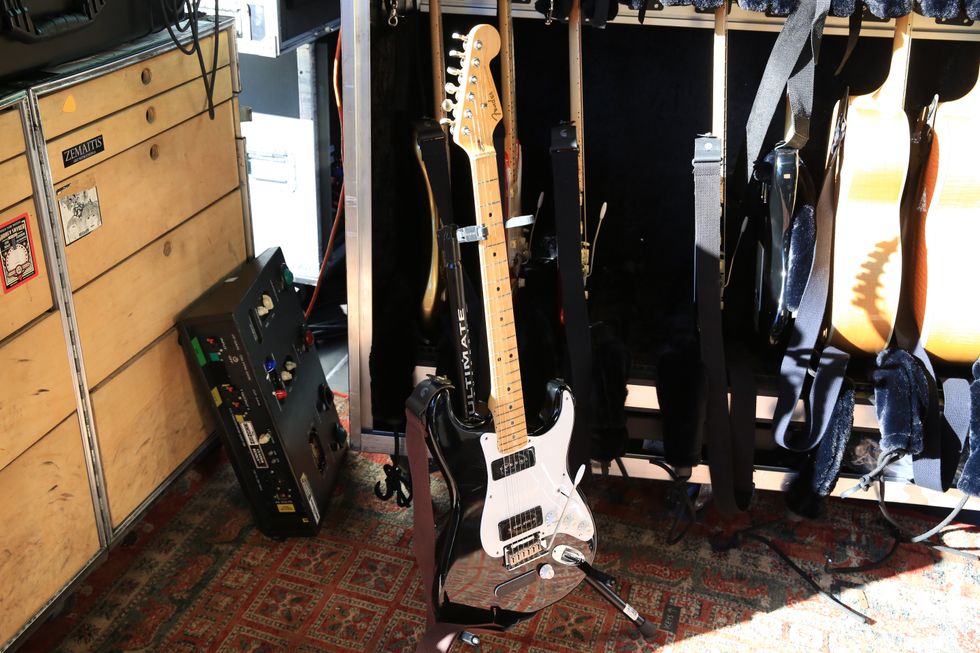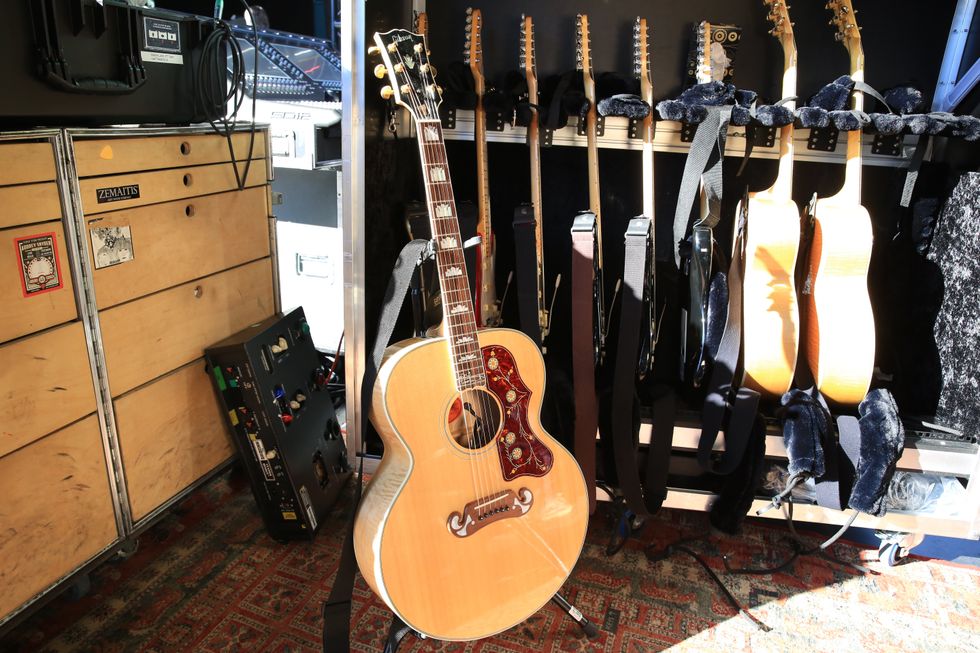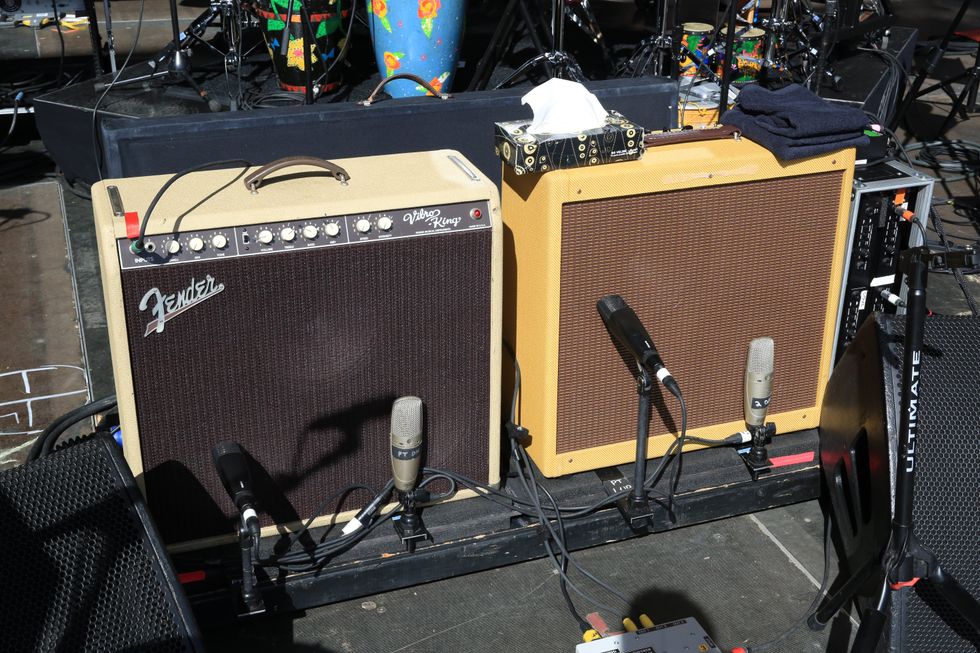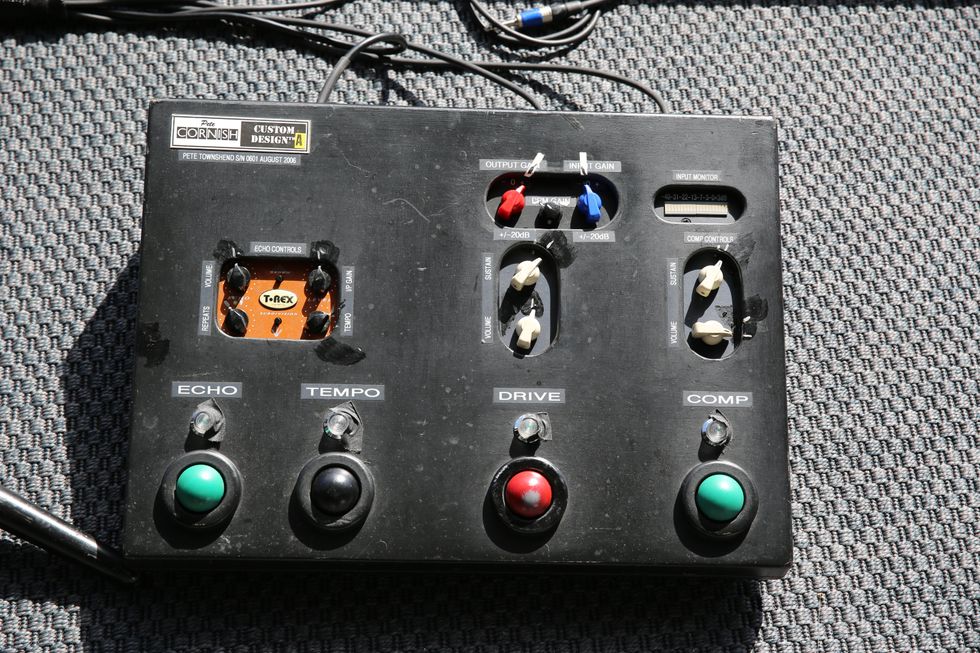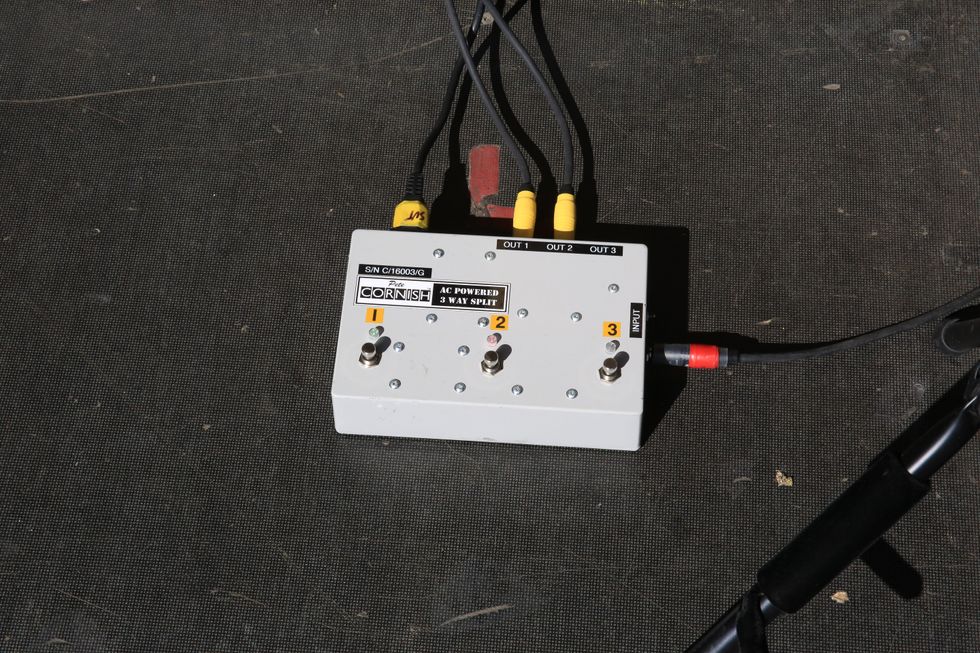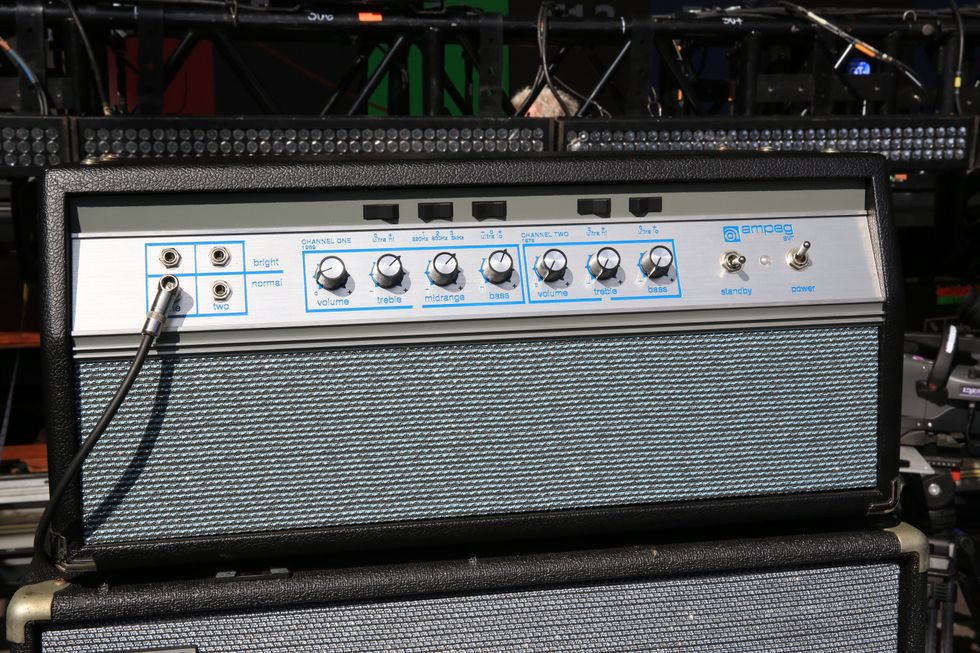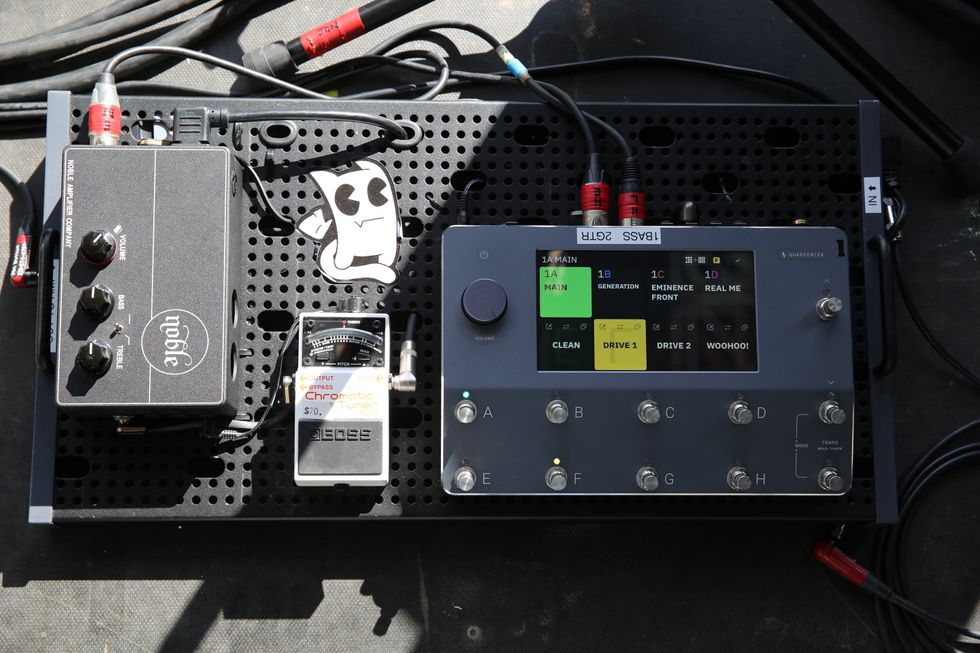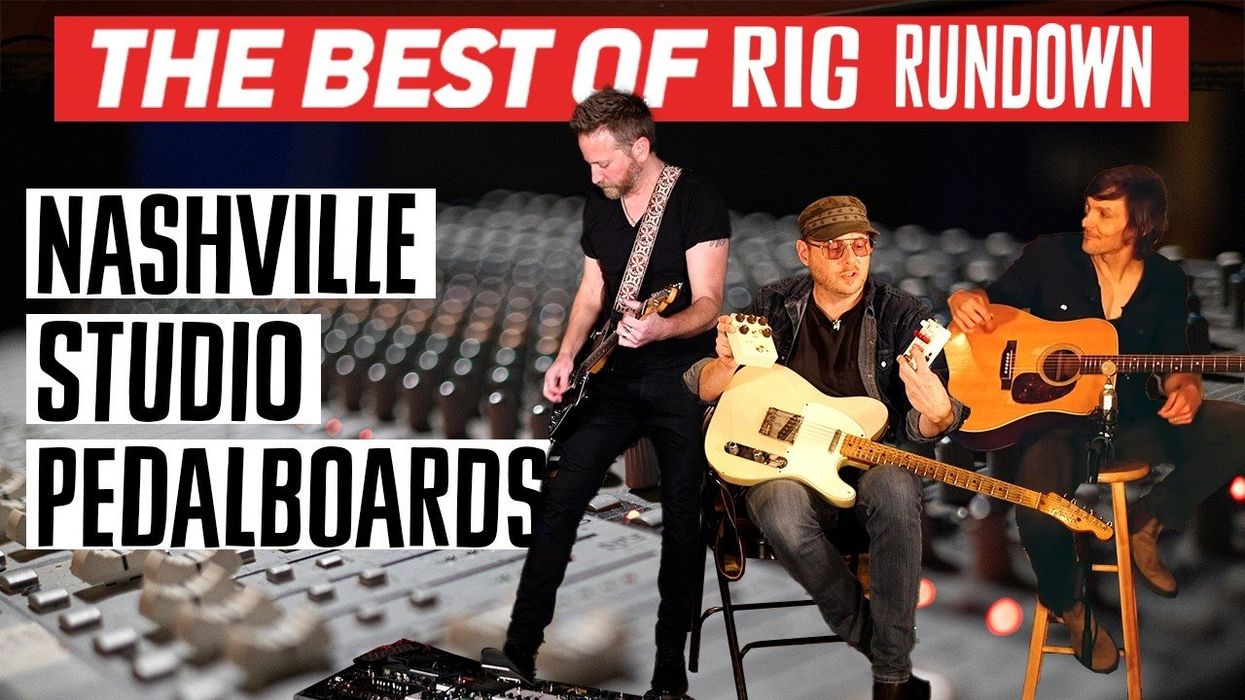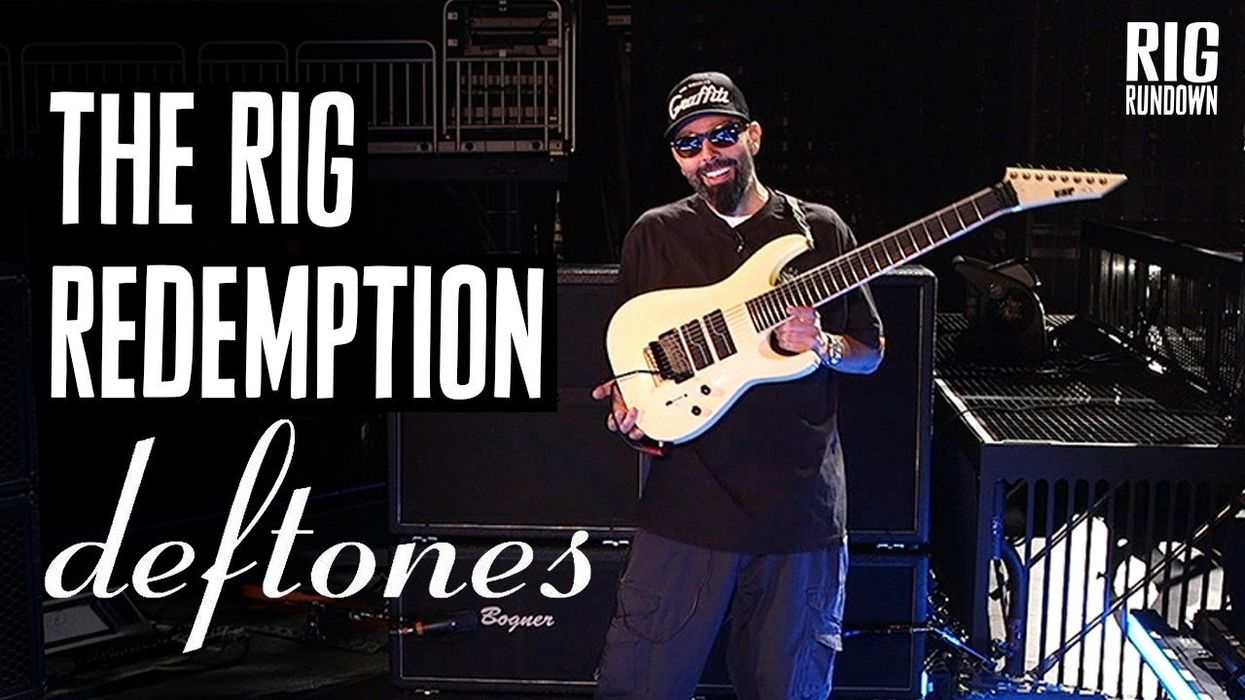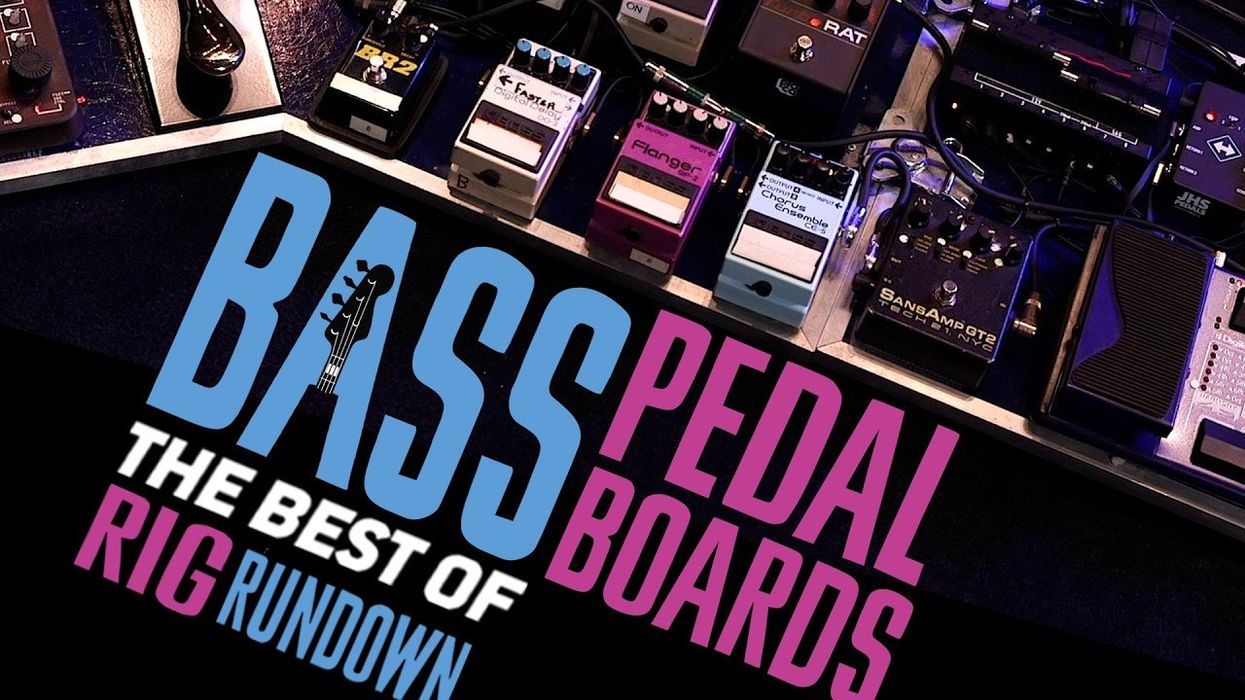These barnstorming bandmates are multi-instrumentalists who parade out a music store's worth of gear that provides all the twangin’, cryin’, moanin’, howlin’, and note-bendin’ that’ll get you two-steppin’ or dropping a tear in your beer.
The Food Stamps have been cooking onstage behind the redheaded songwriter pretty much since he left Appalachia and began touring as a full unit. These loyal road dogs have worn the rubber off the tires touring with Mr. Childers. First, they were strictly a live band enlisted to recreate and recharge the material from his first three studio albums Bottles and Bibles (2011), Purgatory (2017), and Country Squire (2019). But with the last two studio records—the triple-album, gospel-country opus Can I Take My Hounds to Heaven? and last year’s classic-meets-contemporary Rustin' in the Rain—the Food Stamps went from being his road-warrior comrades to eating big time alongside their leader onstage and in the studio.
During Childers’ headlining arena run and before his second sold-out night at the Bridgestone Arena in downtown Nashville, the Food Stamps’ CJ Cain (acoustic/electric guitar/mandolin), Jesse Wells (electric guitar/mandola/banjo/baritone/fiddle), James Barker (guitar/pedal-steel), and Craig Burletic (electric bass/double bass) invited PG’s Perry Bean inside their “living room” stage set. When we last chatted with them in 2019, the boys were burning through the small-club circuit with many of the same tone tools still in their rig today, but as venues grow and tours extend, gear needs change and the arsenal capacity increases. In this hour-long Rundown, we cover all their fresh friends, old standbys, and everything else these four buckaroos require to make music that matters.
Brought to you by:
D’Addario Strings: https://ddar.io/wykyk-rr and https://ddar.io/tuttle-rr
Like New
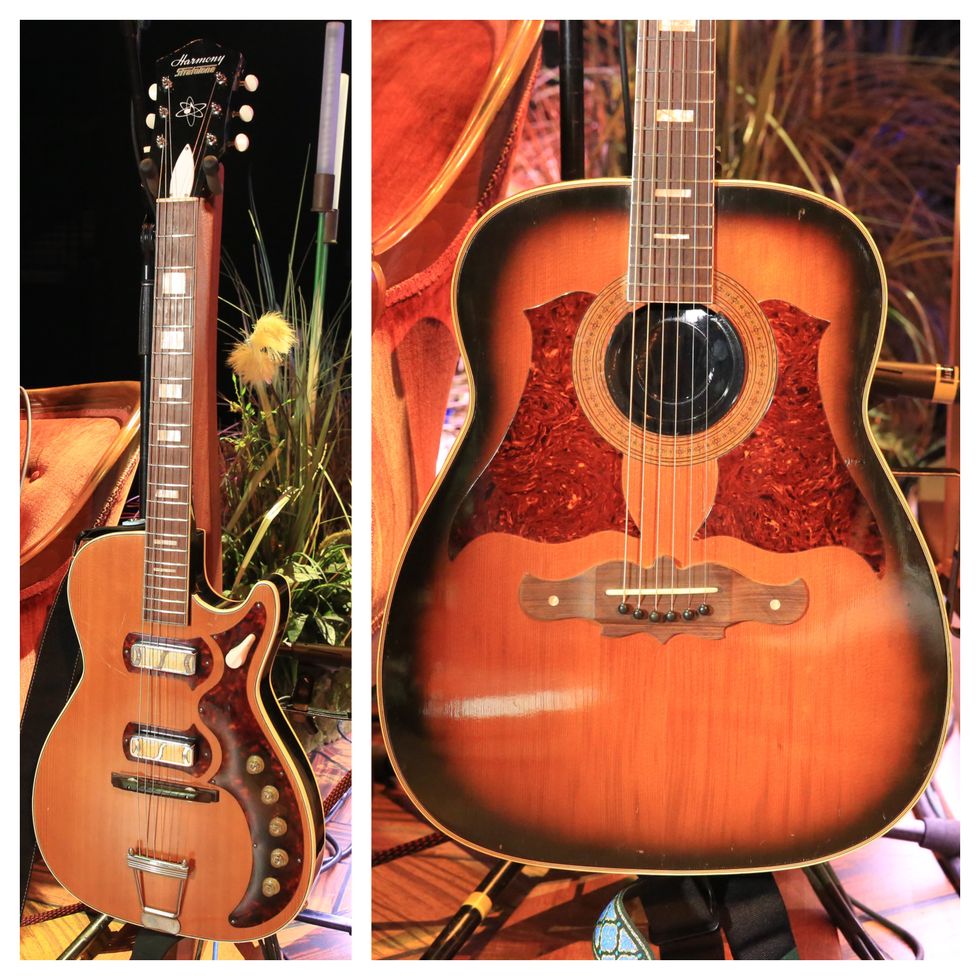
While CJ Cain is the newest member in the Food Stamps, he’s had a long history hanging out and making music with his bandmates in other outfits for years. His addition to the band was a smooth transition and he handles acoustic guitar, electric guitar, and mandolin on a nightly basis. In this Rundown, CJ mentions he’s most comfortable on a dreadnought, but is finding his footing with electric guitar and the accompanying gear.
These old beauts are a pair of vintage Harmony instruments. The electric on the left is a 1960 Stratotone that’s been overhauled with stainless-steel frets, Waverly tuners, and a proper setup. The big boomer on the right is a 1960s H1266 Sovereign Deluxe that also has been upgraded with stainless-steel frets and plays like a dream. The H1266 has a midrange like a Mack truck and sat in the mix really well for the Rustin’ in the Rain sessions. All of his acoustics take D’Addario XTAPB1356 XT Phosphor Bronze strings and his Stratotone uses D’Addario NYXL1149 Nickel Wound strings.
A Class
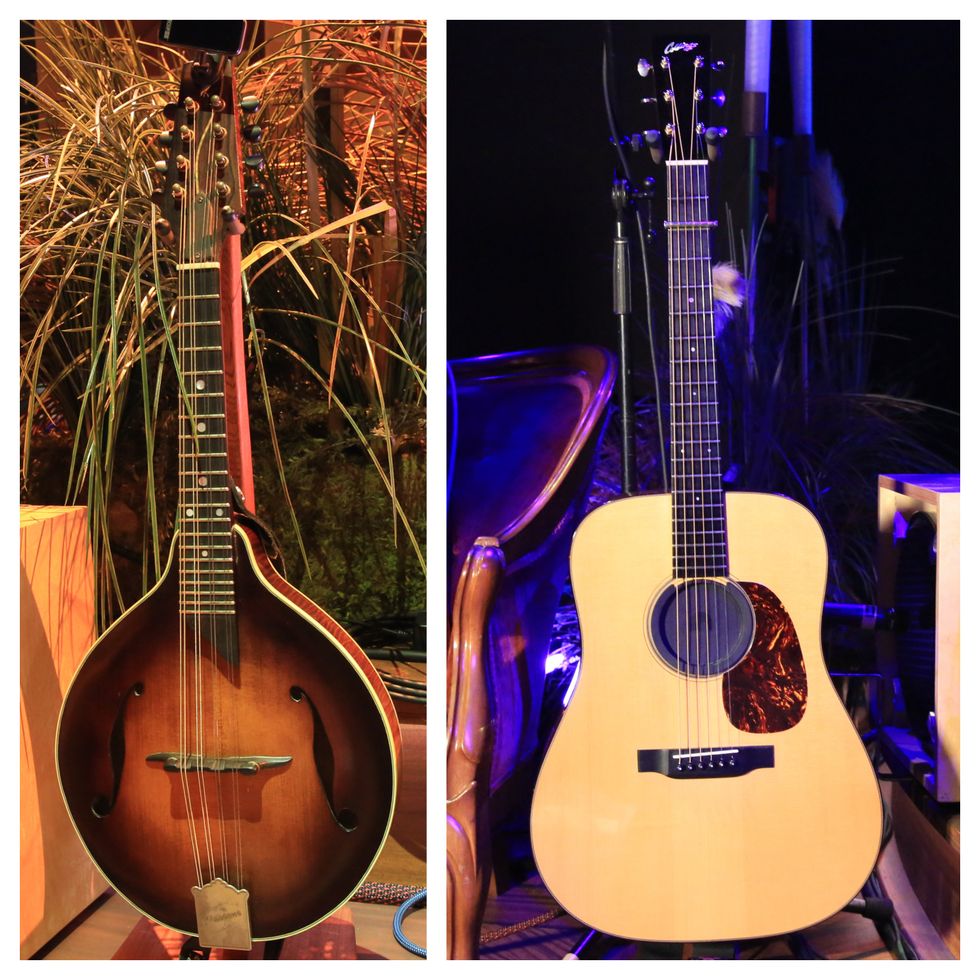
Cain’s friend Will Parsons has been hand-carving mandolins in Elizabethton, TN, since he was 14 years old. This A-style mando is barky and choppy, qualities that let it gnash through their full-band spread.
The 14-fret dreadnought on the right is a Collings D1A that has a Sitka spruce top, Honduran mahogany back, sides, and neck (modified V profile), an ebony fretboard, bone nut and saddle, nickel Waverly tuners, and pre-war scalloped X-brace pattern (with Sitka spruce).
Lucky Loaner
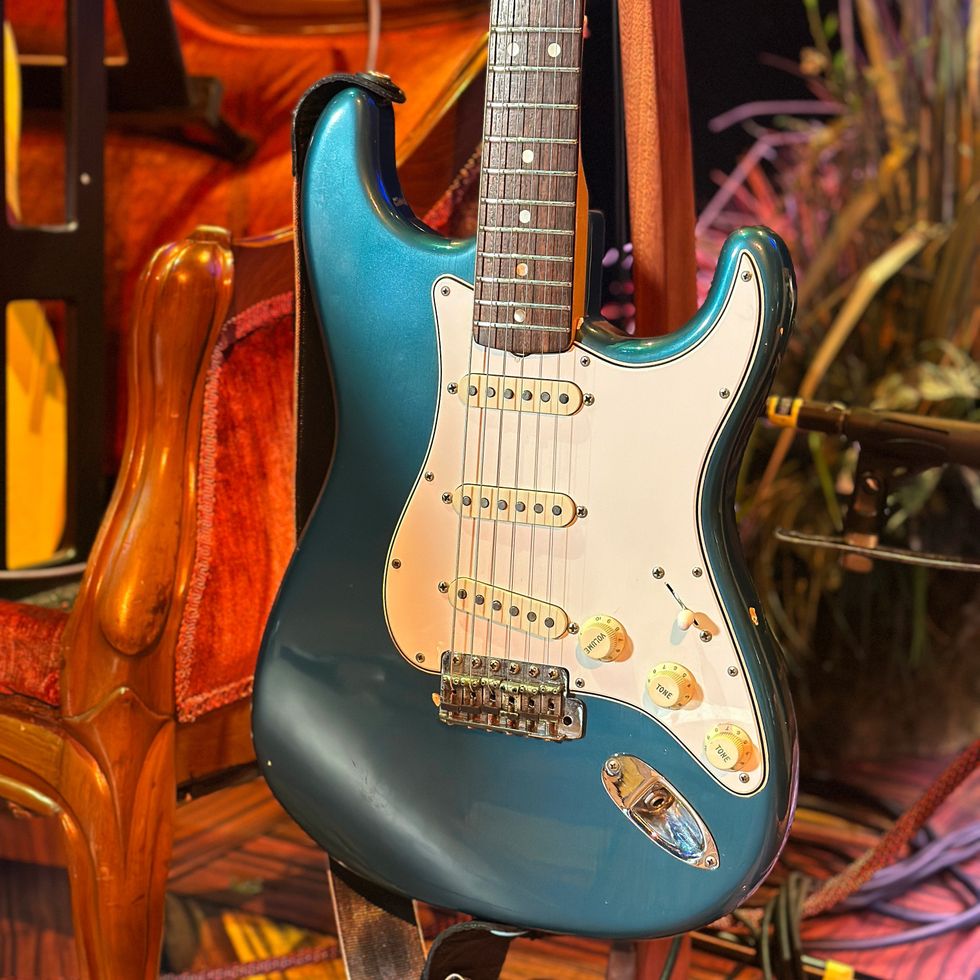
Here’s a 1966 Stratocaster that Cain was able to bring on the road from an encouraging friend. He notes that it’s a “magical guitar.” The owner let Cain play it as a teenager and recently let him dust it off for this year’s Mule Pull tour with Tyler Childers. This one rocks D’Addario NYXL09544 Nickel Wound strings.
CJ Cain’s (Electric) Pedalboard

His “trial-by-fire” christening into electric guitar has sparked the need for some pedals and his current stable includes a Dunlop EP103 Echoplex delay, a Keeley Mini Katana Clean Boost, a Kingsley Page Tube Boost, a Greer Lightspeed, a JHS Pulp ’N’ Peel V4 compressor, and a Peterson StroboStomp HD.
One Nation, Under Tone
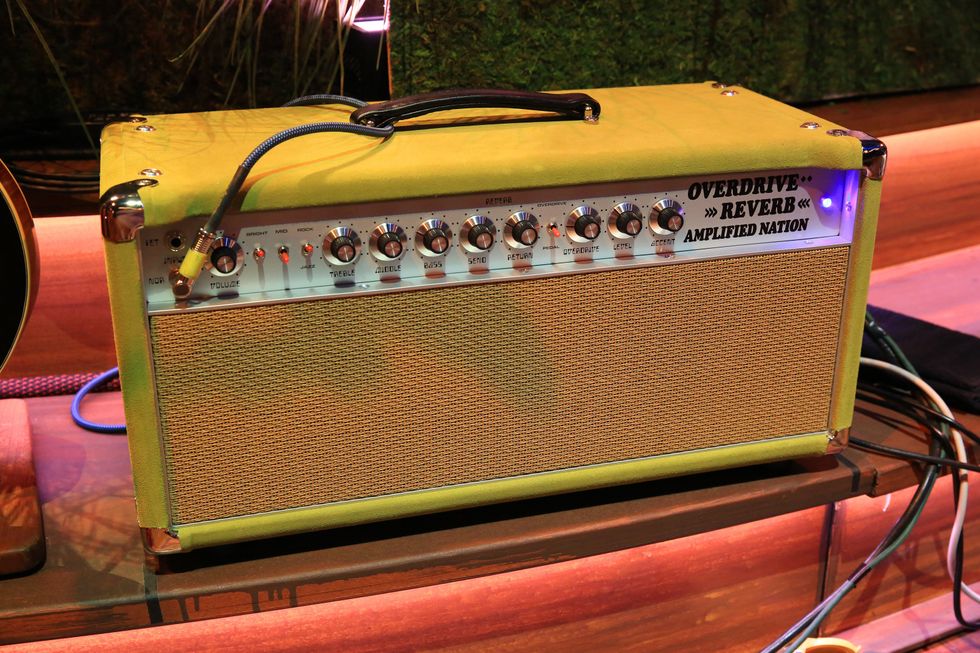
The Harmony and Strat run through CJ’s electric board and then hit his Amplified Nation Overdrive Reverb that plugs into a 1x12 extension cab, which runs a JBL D120F speaker taken out of a 1970 Fender Twin Reverb.
CJ Cain’s (Acoustic) Pedalboard
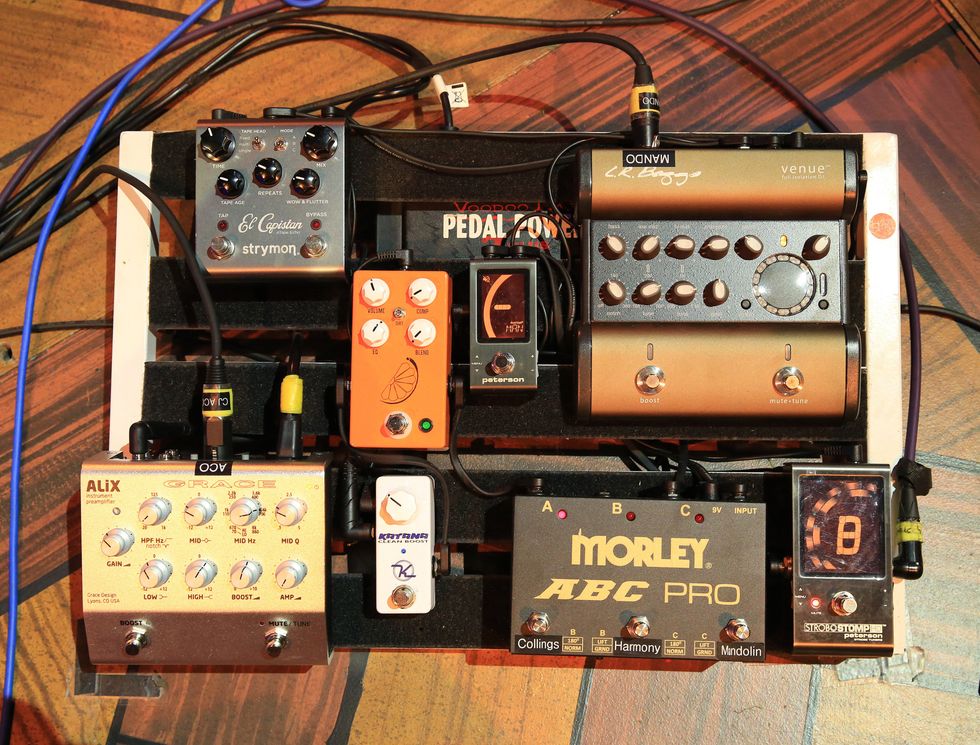
CJ Cain’s (Acoustic) Pedalboard
Covering his coloring, switching, and tuning needs for flattops and mandolin are a Strymon Flint, another JHS Pulp ’N’ Peel, a Grace Design ALiX preamp, a Keeley Mini Katana, a L.R. Baggs Venue DI, a Morley ABC Pro Switcher/Combiner Pedal, and a pair of Peterson StroboStomps.
Sturdy Steeds
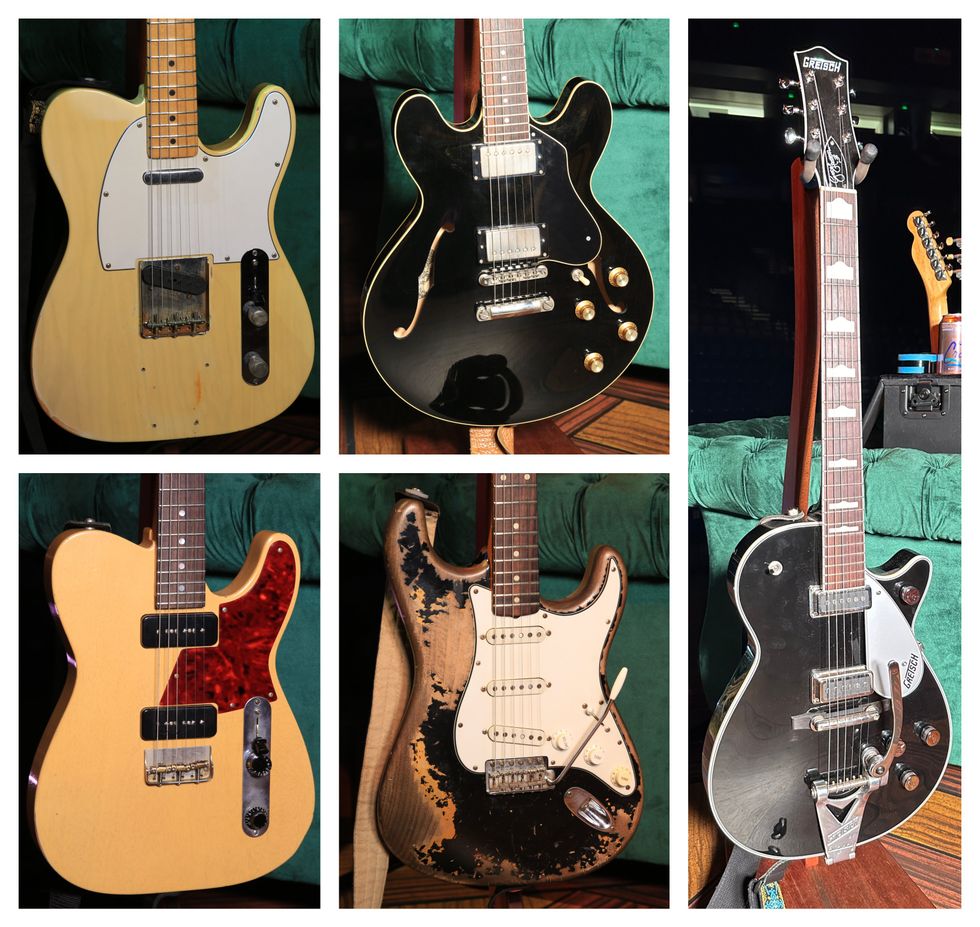
“This is the heartbeat of my rig,” contends Jesse Wells. The kickstart to his rig’s heart is a 1968 Fender Telecaster (top left) that once upon a time had a Bigsby vibrato on it. He bought it off Food Stamps’ tech Patrick Boyle, who still gets to see his old friend every night. The ES-style guitar is a Collings I-35 (top right) has been upgraded with ThroBak PAF humbuckers. RS Guitarworks (lower left) created this Slab Series mashup that blends a T-style with an LP Junior. The pickups are a set of growly Fralin Soapbar P90s. One of the Bluegrass State brothers built him this relic’d partscaster that has a set of Ron Ellis 64S single-coils. And on the far right is a Gretsch G6128T-GH George Harrison Signature Duo Jet that Wells wanted for mellower vibes, and into which he dropped a set of Ron Ellis Ellisonic JLs codesigned by the masterful Julian Lage.
The Oddities
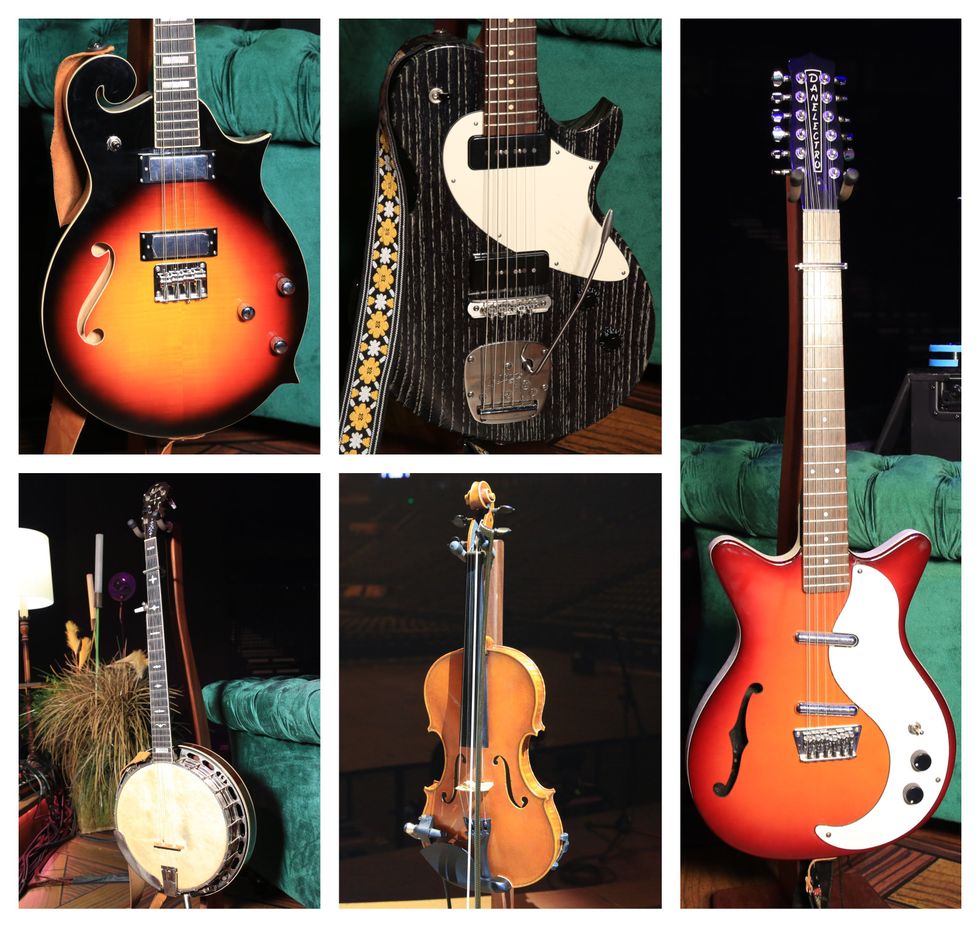
As the man in the band that wears the most hats, Jesse Wells carries a lot of auxiliary instruments. Starting with the Eastwood MRG Tenor (top left), a fancy little unit with mini humbuckers. Next is the Collings 360 Baritone that has a 27.5" scale length and custom Lollar Alnico Pole P90s. Then he has the Gibson RB-250 5-string banjo and a violin handmade by Jonathan Cooper out of Portland, Maine. On the far right is Wells’ Danelectro 59X12 12-string.
Mighty Mites
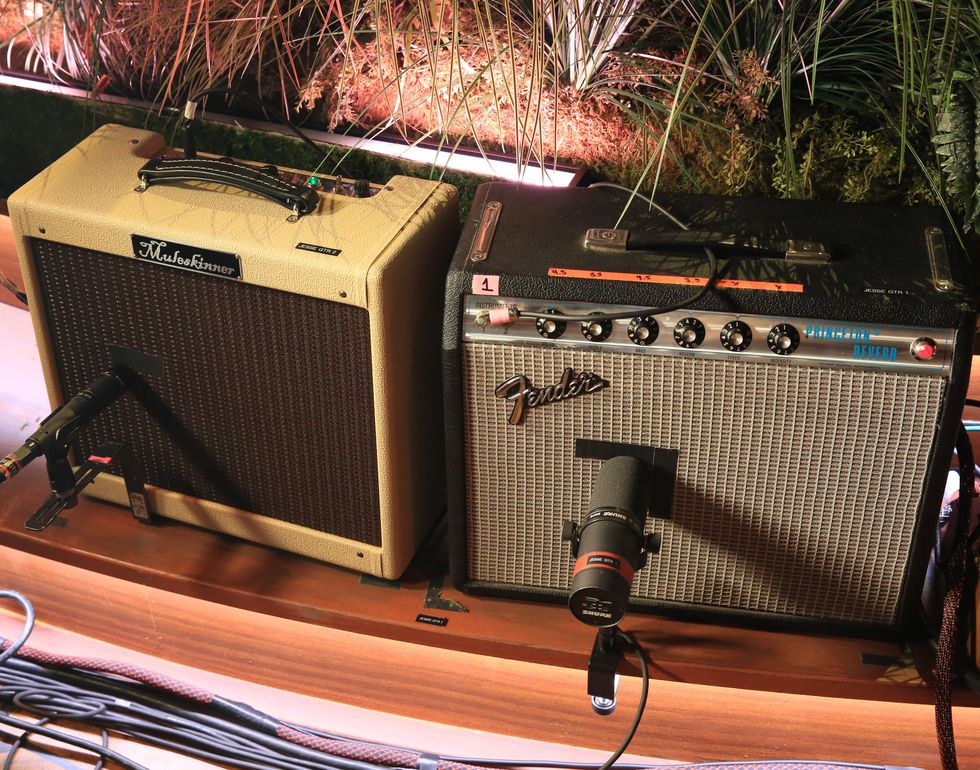
Letting FOH and PA do a lot of the work, Jesse utilizes a pair of puny punchers—a Muleskinner Tweed based on the 5E3 circuit with a couple 6V6s, and a 1974 Fender Princeton Reverb.
Jesse Wells’ Pedalboards
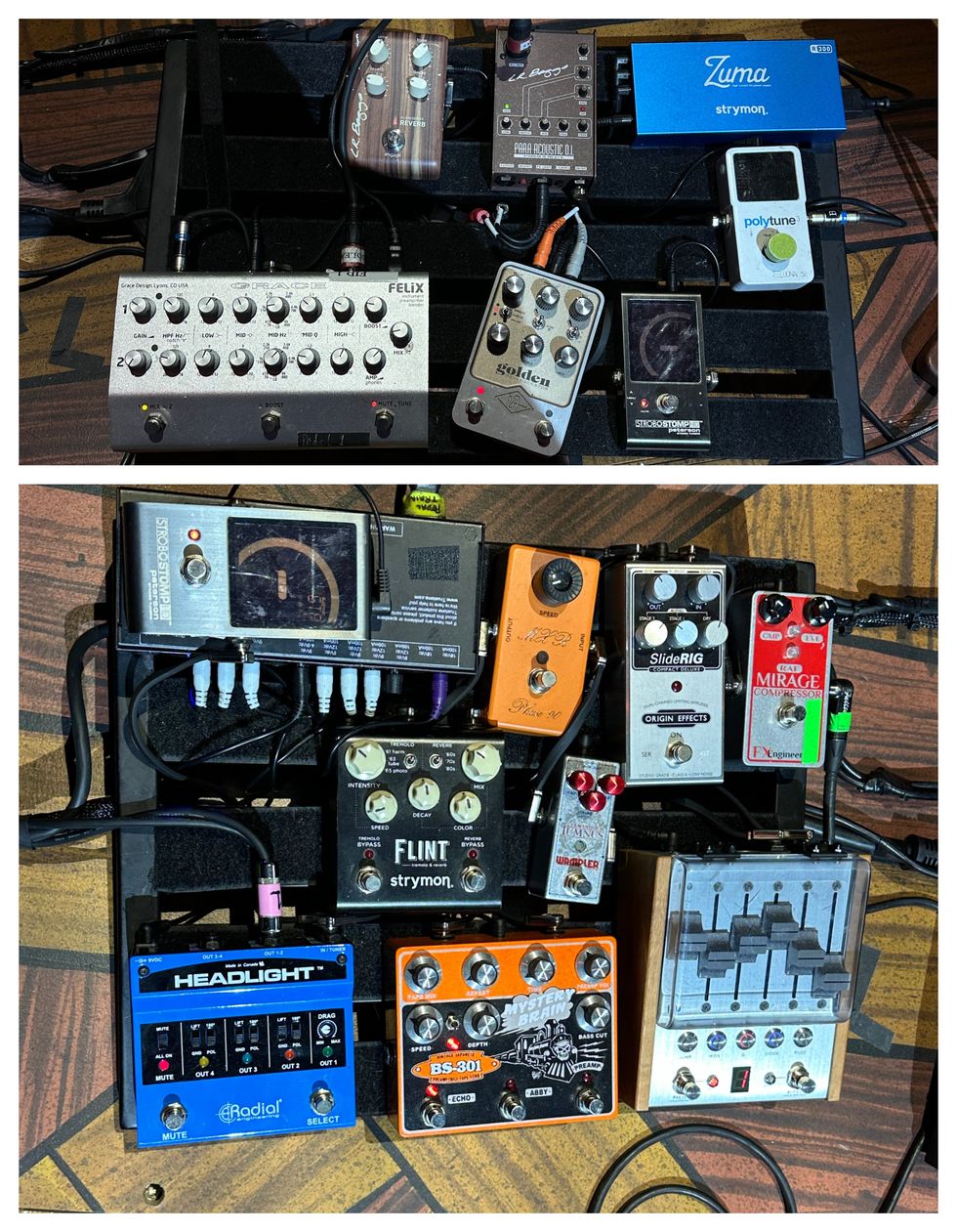
Up top is the board for Jesse’s fiddles and banjo, which both go to a Grace Design FELiX2 preamp, a duet of L.R. Baggs pedals—an Align Reverb and Para DI Acoustic Guitar Preamp—a Universal Audio Golden Reverberator, and two tuners (TC Electronic PolyTune3 and Peterson StroboStomp HD). A Strymon Zuma powers everything.
The electric board that handles everything else includes a Strymon Flint, MXR Phase 90 (script logo), Origin Effects SlideRIG Compact Deluxe, FX Engineering RAF Mirage Compressor, Wampler Germanium Tumnus, Nocturne Brain Mystery Brain BS-301 tape echo, and Chase Bliss Automatone Preamp. Utility boxes include a Peterson StroboStomp HD tuner, a Radial Headlight Amp Selector, and Truetone 1 SPOT PRO CS12 power supply.
James’ Barkers

For this arena run, James Barker took out a handful of electrics. The candy-apple red Fender Eric Johnson Strat is the lone instrument that he had during the last Rundown. Barker mentions, “It’s all stock. I’ve never done anything to it, and it’s one of my favorite guitars in existence.” Next is a USA-made Epiphone Casino that has a laminated maple-poplar-maple body, a rounded-C mahogany neck, bound rosewood fretboard, and a pair of gnarly Gibson dogear P90s. Then we have a glowing Rickenbacker 1993Plus 12-string that gets busted out for “Universal Sound.” A Gretsch G6122T-62GE Vintage Select Country Gentleman hollowbody gives Barker some traditional country-western twang. And finally on the right side we have a CME Exclusive Gibson Les Paul Standard ’50s that boasts a dazzling “Dirty Lemon Burst” finish that was inspired by the organically fading cherry bursts from the holy-grail period.
Lonesome Whippoorwill
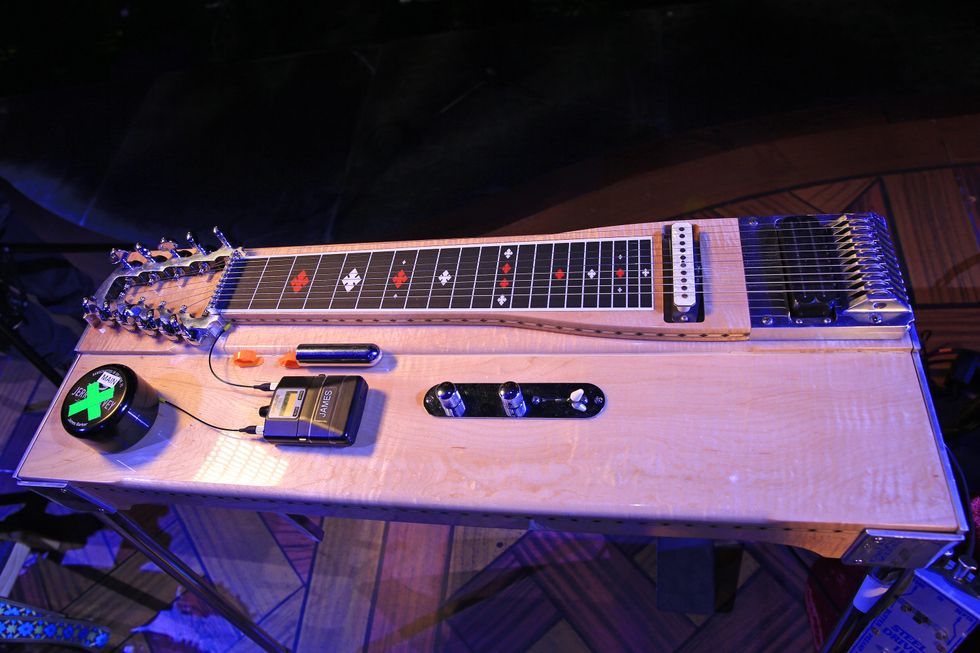
Our 2018 tour visit with the Food Stamps saw Barker using a Sho-Bud pedal-steel guitar. All of his repairs on that 10-string beast were done by Nashville luthier Jeff Surratt who owns and operates Show Pro Steel Guitars. Just before COVID shut down tours, Barker received his custom 10-string Show Pro model seen above, and has been enjoying bending notes and sliding all over it ever since.
Get Amped!
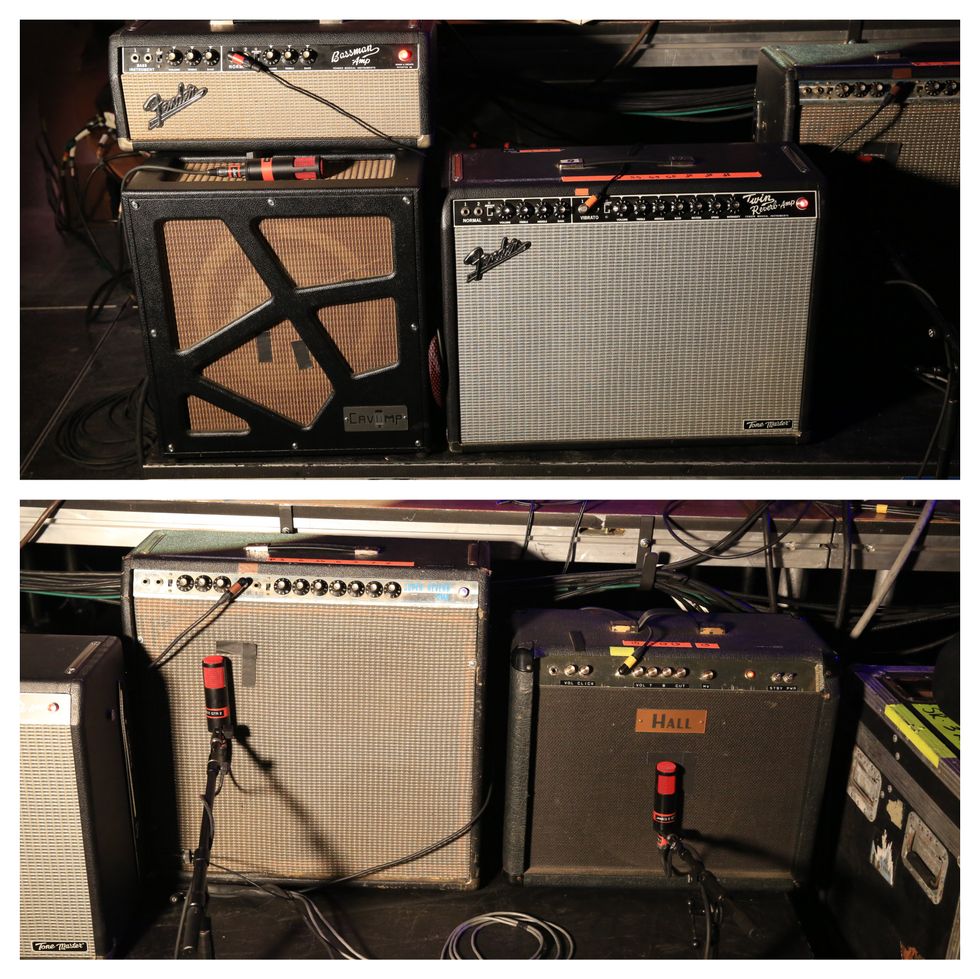
James plays through a pair of amps all night. The pedal-steel Show Pro hits an old Fender Bassman that powers a CavAmp passive rotary speaker cabinet. For the steel’s main tone, Barker relies on a Fender Tone Master Twin Reverb. When he’s playing electric guitar, he drives with the custom-voiced Hall combo (seen in the last Rundown) and a 1970s Fender Super Reverb that’s been modded by removing the first channel’s tone stack (when he hits the bright switch), giving the amp a lot of volume and gain. The Hall is a two-channel design with the right channel (his prime choice) modeled after a Trainwreck Rocket, while the left channel is similar to a Gibson GA-40. The Super Reverb is used for clean parts, and the Hall is for rockin’.
James Barker’s Pedalboards
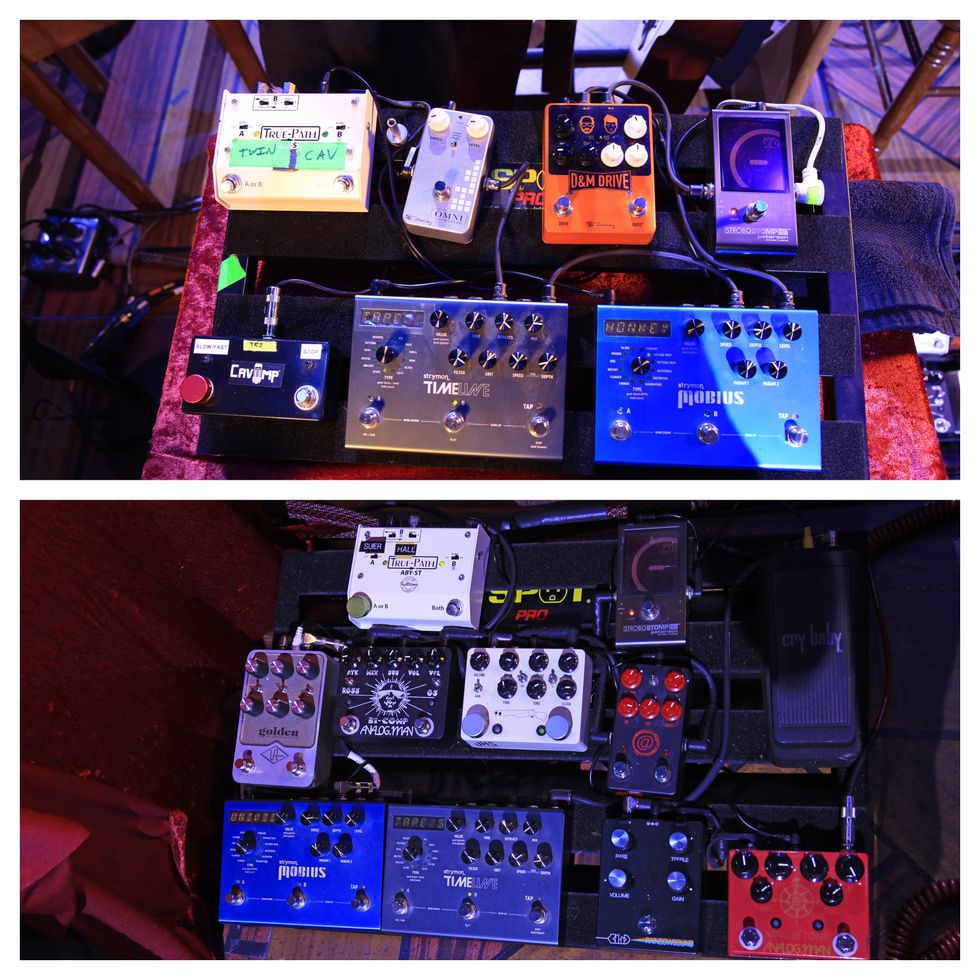
To accommodate his dual duties, he’s got a pair of pedalboards. Up top is his steel board that uses a Keeley Omni Reverb, Keeley D&M Drive/Boost, Strymon Mobius, and Strymon TimeLine. A Fulltone True-Path ABY Soft Touch switcher controls the amps, while a CavAmp box handles the rotary speaker speeds and stops. His steel is kept in check with a Peterson StroboStomp HD tuner.
Down below is his electric-guitar stomp station that has some duplicates from the steel board (Strymon TimeLine & Mobius, Fulltone True-Path ABY Soft Touch switcher, and Peterson StroboStomp). The fresh faces include a Universal Audio Golden Reverberator, an Analog Man Bi-CompROSSor, a JHS Double Barrel, a JHS AT Drive V2, a Kogoy Musical Devices Rainbowsound, an Analog Man King of Tone, and a Dunlop 535Q Cry Baby.
All About That Bass
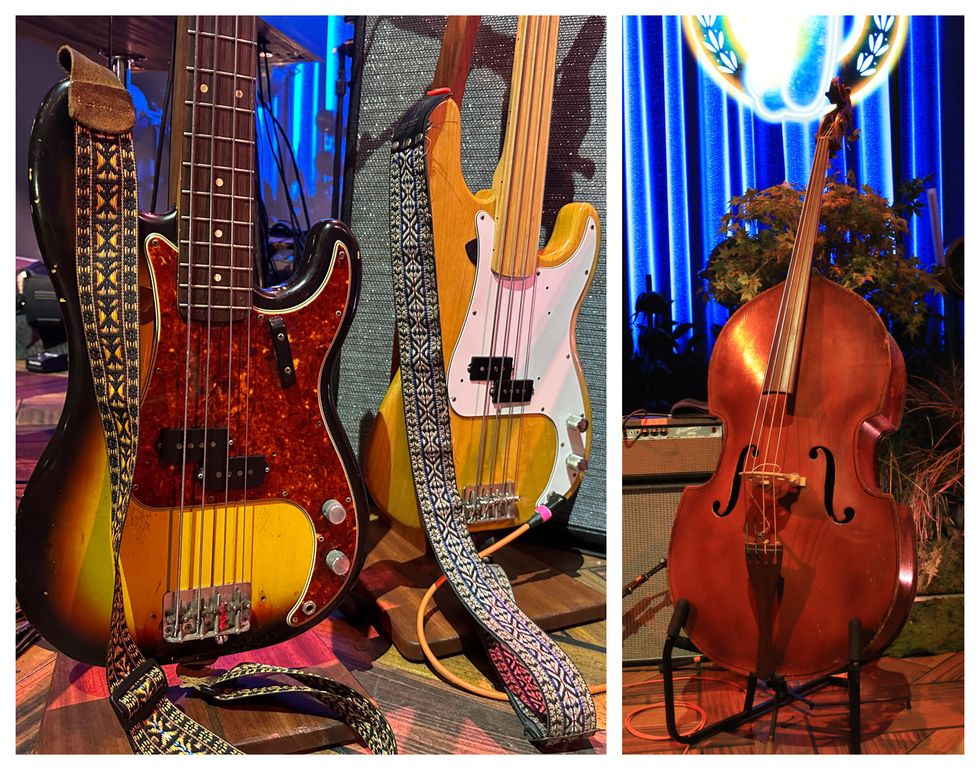
Bassist Craig Burletic hasn’t met a 4-string he couldn’t thump. Back in 2018 he was boogying down on a sunburst 2011 Fender P, but he’s since acquired a similar-looking P from 1965 that actually is decked out in pre-CBS specs. He purchased this special instrument off fellow bassist J.T. Cure, who’s in Chris Stapleton’s band. Burletic was floored with the vintage Precision and pinches himself each night because as he puts it, “I didn’t know basses could sound so good.” If you look closely at the D string off the bridge, you’ll notice a bulky burl hanging near the saddle. It’s actually the end of a double-bass string that he slapped on when his standard electric-bass string snapped during a “middle-aged” jam out. He didn’t have any extra electric-bass strings so he put on the double-bass D gut string and hasn’t looked back.
While studying at Marshall University, Burletic fell in love with a 1974 fretless Fender P bass. He learned how to play upright bass on that instrument and wanted to buy it from Marshall, but found the bureaucratic hoops a bit much. However, a few years later he found this fretless 1972 P with a rare maple neck and fingerboard. His double bass is an old American Standard that he scooped off Facebook Marketplace.
10 Outta 10!
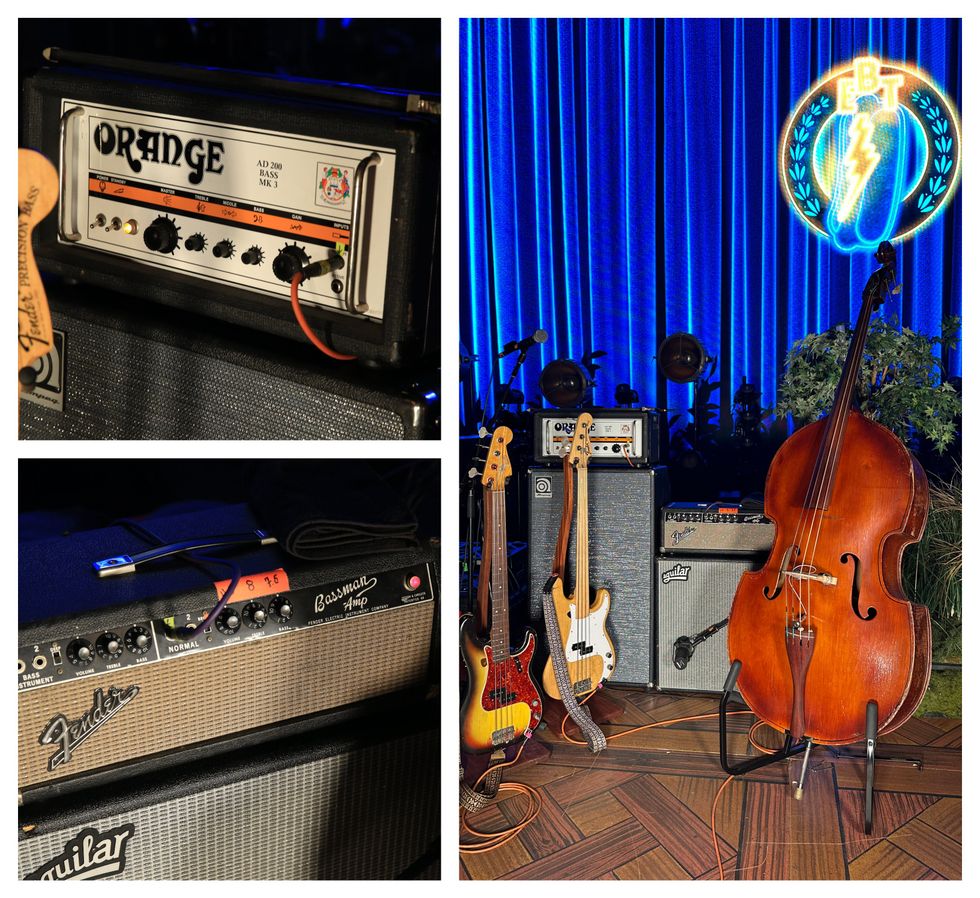
Burletic brings the low-end rumble with a pair of thunder buddies—an Orange AD200B MK3 200-watt bass head and an old Fender Bassman. The Orange goes into a Ampeg Heritage SVT 610AV cabinet while the Fender runs through an Aguilar DB 410 cab. And you gotta love the looks of his full setup glowing under the EBT (Eatin’ Big Time) logo.
Craig Burletic’s Pedalboard
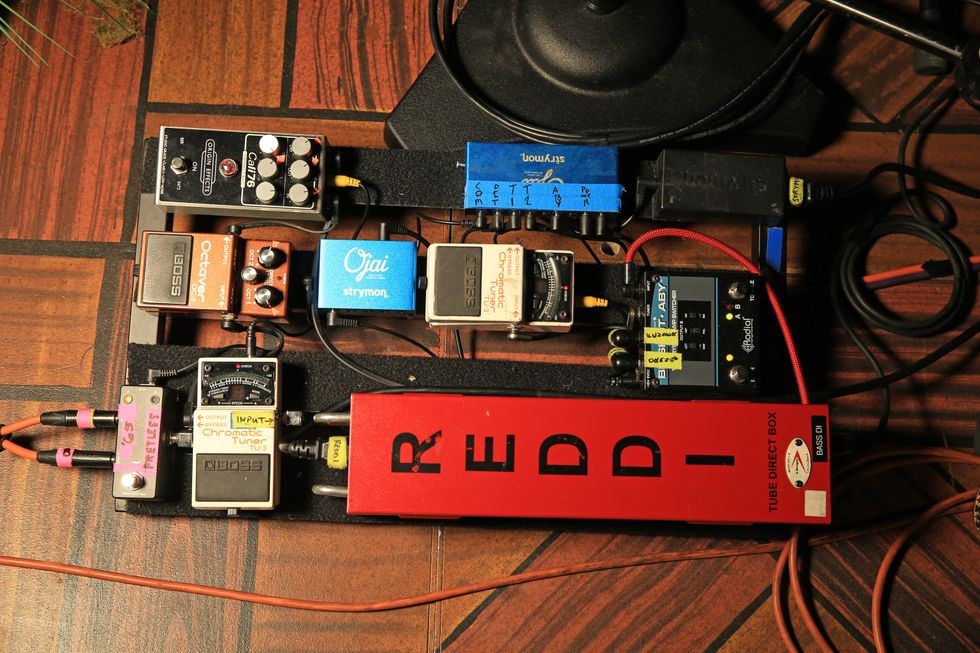
No pedals were on the floor for Burletic last time, but he’s since fleeced out a proper pedalboard for the arena tour (even if most of the boxes are utilitarian units). The actual tone twisters are a Boss OC-2 Octaver and an Origin Effects Cali76 Compact Bass Compressor. An A Designs REDDI DI box helps give FOH a crystal bass signal, while the Radial BigShot ABY wrangles the amps. Then he has a pair of Boss TU-3 Chromatic Tuners and double Strymon Ojai power supplies.
Childers’ Children
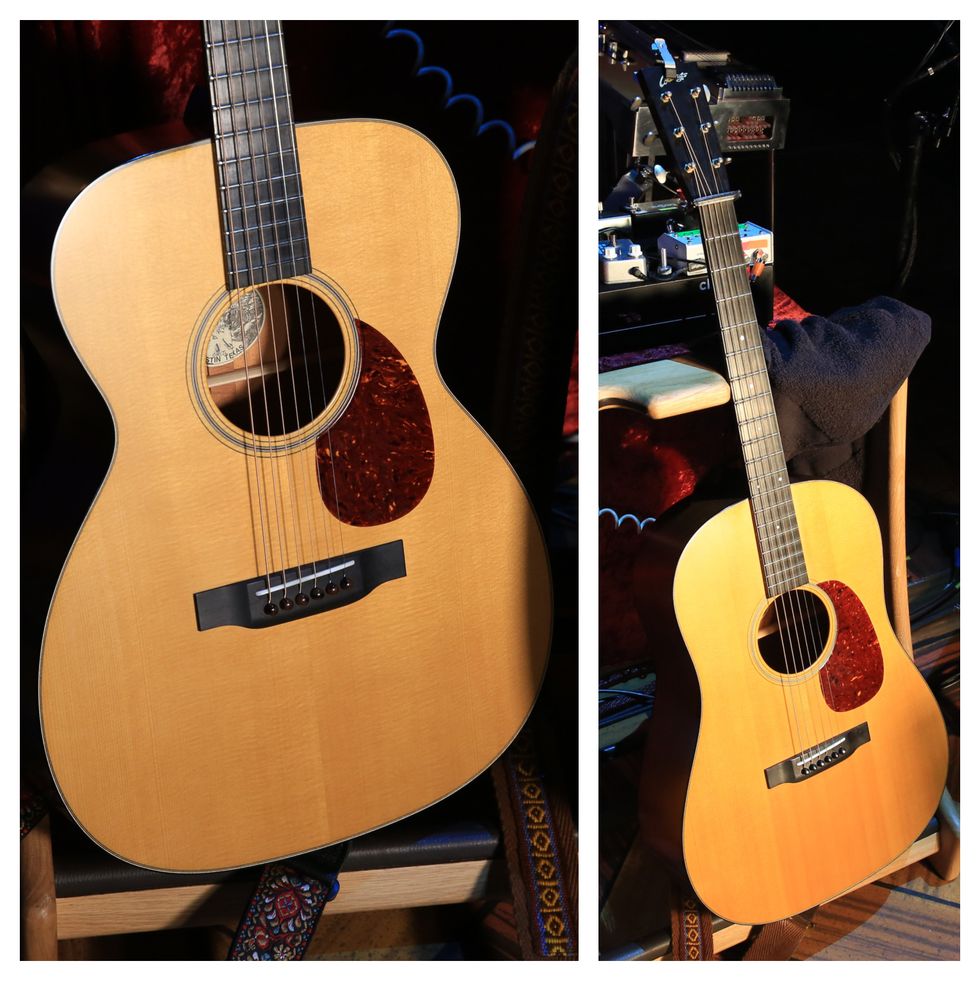
Tyler Childers has long been loyal to Collings. He used them exclusively during our last Rig Rundown, and he’s still plucking those Collings like they owe him money. For a while, his No. 1 was the DS1A (right), but just a few days before we interviewed the gang, the Collings OM1 Julian Lage showed up and since then it’s been used 99 percent of the time. It has many traditional orchestra-model specs (Sitka spruce top, Honduran mahogany back, sides and neck, medium nickel frets, and bone nut and saddle), but what makes this small-bodied acoustic special are the intricate requests from Lage, like recreating the neck profile of his 1939 Martin 000-18 and using a custom satin lacquer that makes the new guitar feel and sound old. FOH has noted that the smaller acoustic with less bass sits much better in the full-band mix. Both acoustics take D’Addario Medium Phosphor Bronze strings (.013–.056).
Tyler Childers’ Pedalboard
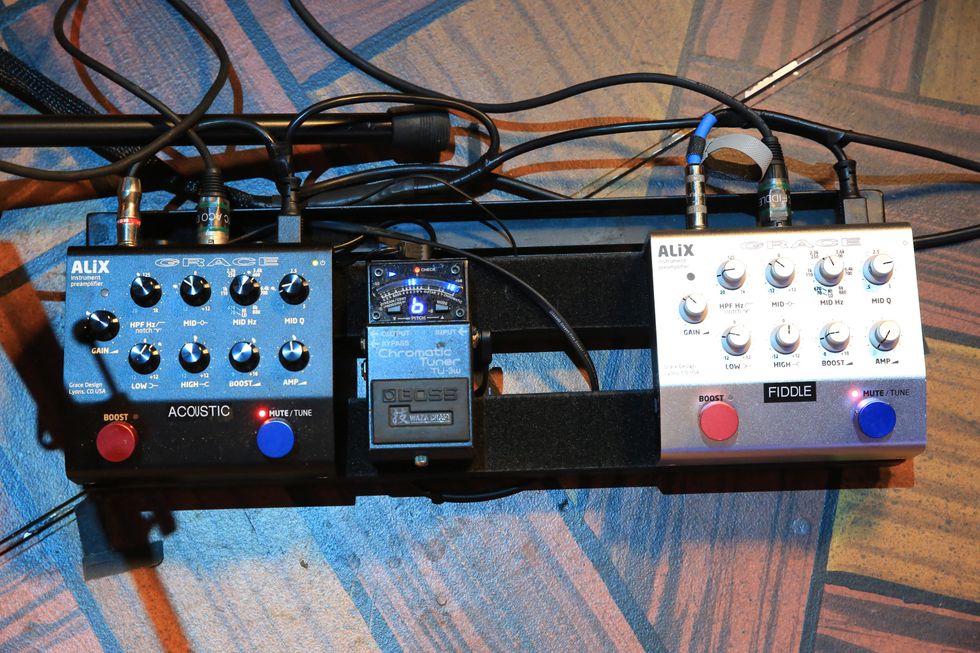
For a picker that mainly plays acoustics, his board is expectedly tame with a pair of Grace Design ALiX preamps (one for the Collings and another for fiddle) and a Boss TU-3w Waza Craft Tuner.
TV Time!
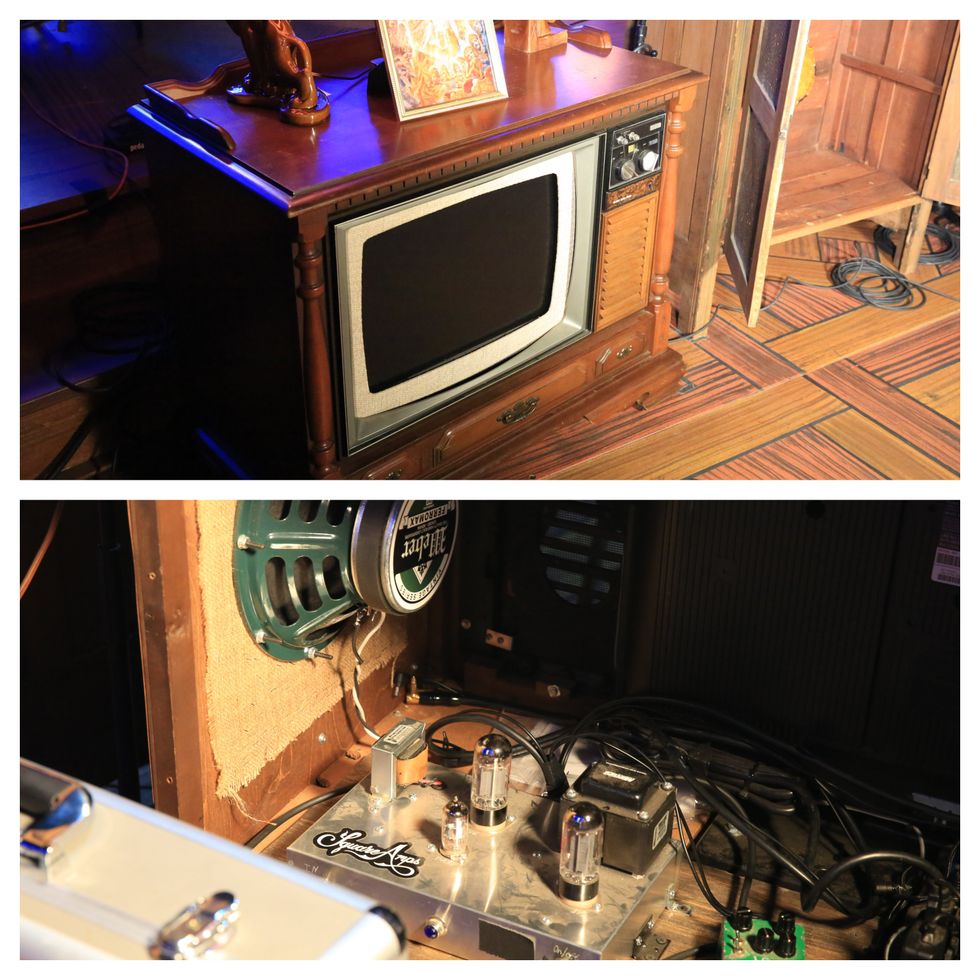
When Childers does grab an electric and throw down (usually during instrumental “Two Coats” from Can I Take My Hounds to Heaven?), he’ll get loud with this old TV that was actually his grandfather’s RCA set. On the backside rests a custom Square Amps head that Matt Richards built upon Tyler’s request. (Head here to read its quick backstory.) It has a single 12" Weber Vintage Series Ferromax speaker.
Shop the Food Stamps' Rig

Fender Stories Collection Eric Johnson 1954 "Virginia" Stratocaster
Fender Vintera II '60s Stratocaster
Amplified Nation Overdrive Reverb 50-watt Tube Head
Dunlop EP103 Echoplex Delay Pedal
Keeley Katana Mini Clean Boost Pedal
JHS Pulp 'N' Peel V4 Compressor Pedal
Peterson Strobostomp
Strymon El Capistan
LR Baggs Venue DI
Grace Design ALiX Acoustic Instrument Preamp / EQ / DI / Boost Pedal
Morley ABC Pro 3-button Switcher/Combiner Pedal
Fender Custom Shop Time Machine '68 Thinline Telecaster Journeyman Relic
Gretsch G6128T-GH George Harrison Duo Jet
Danelectro 59X12 12-string Electric Guitar
Fender '64 Princeton Reverb 1x10"
Grace Designs Felix Preamp
LR Baggs Acoustic Series Reverb
LR Baggs Para Acoustic DI
Universal Audio UAFX Golden Reverberator Pedal
TC Electronic PolyTune
MXR Phase 90 Script
Strymon Flint
Wampler Tumnus
Radial Engineering Headlight
Gibson Custom 1959 Les Paul Standard Reissue Electric Guitar - Murphy Lab Light Aged Dirty Lemon
Epiphone USA Casino Hollowbody Electric Guitar
Rickenbacker 360/12C63 12-String Electric Semi-Hollow
Gretsch G6122T-62GE Vintage Select Country Gentleman
Fender Tone Master Twin
Fender Super Reverb
JHS Double Barrel V4
JHS AT (Andy Timmons) Drive V2 Pedal
Dunlop CBM95 Cry Baby Mini Wah Pedal
Strymon Mobius
Strymon Timeline
Keeley Omni Reverb
Keeley D&M Drive
Fender Tony Franklin Fretless Precision Bass
Orange AD200B MK 3 200-watt Bass Head - Black
Ampeg Heritage SVT-810AV 8x10"
Aguilar DB 410
Origin Effects Cali76
Boss OC-2 Octaver
Boss TU-3 Tuner
Radial Bigshot ABY
A Designs Reddi Tube Direct Box
Boss Waza Craft Tuner TU-3w
Dunlop 511P100 Primetone Standard Smooth Guitar Picks 1.0mm 3-pack
D’Addario XTAPB1356 XT Phosphor Bronze Strings
D'Addario NYXL1149 NYXL Nickel Wound Strings
D’Addario NYXL09544 NYXL Nickel Wound Strings
![Tyler Childers & the Food Stamps Rig Rundown [2024]](https://www.premierguitar.com/media-library/rig-rundown-tyler-childers-the-food-stamps-cj-cain-jesse-wells-james-barker-craig-burletic.jpg?id=52418575&width=1200&height=675)


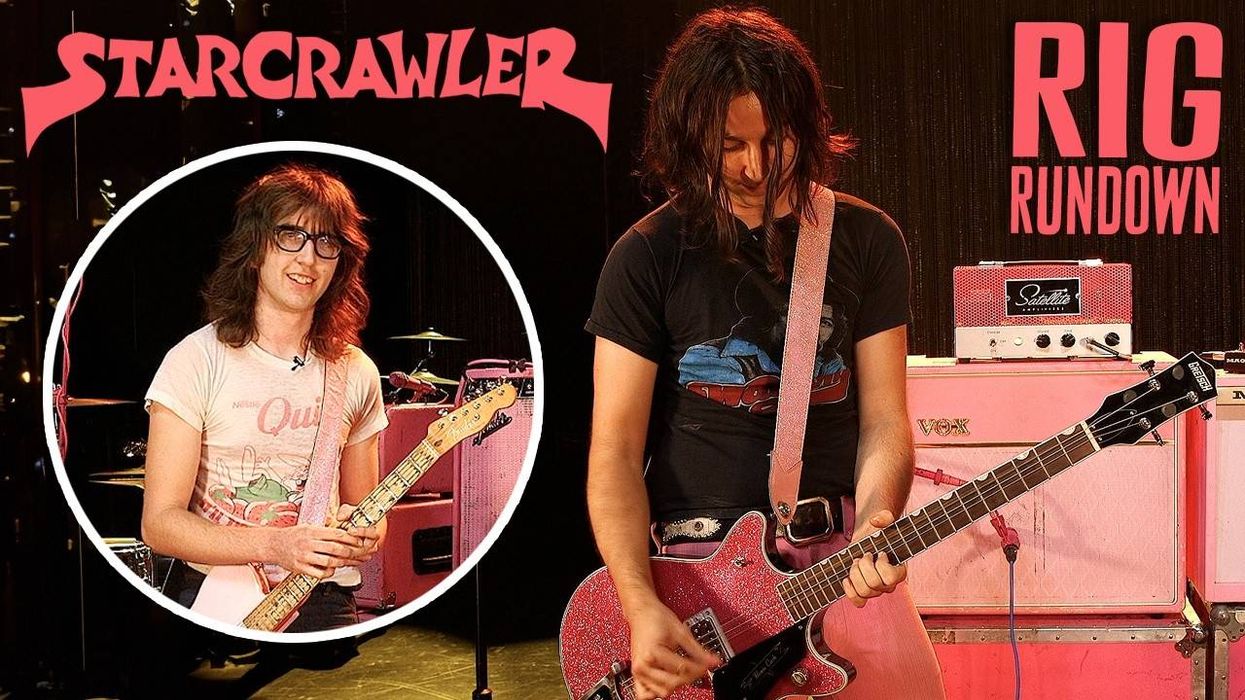
![Devon Eisenbarger [Katy Perry] Rig Rundown](https://www.premierguitar.com/media-library/youtube.jpg?id=61774583&width=1245&height=700&quality=70&coordinates=0%2C0%2C0%2C0)

































